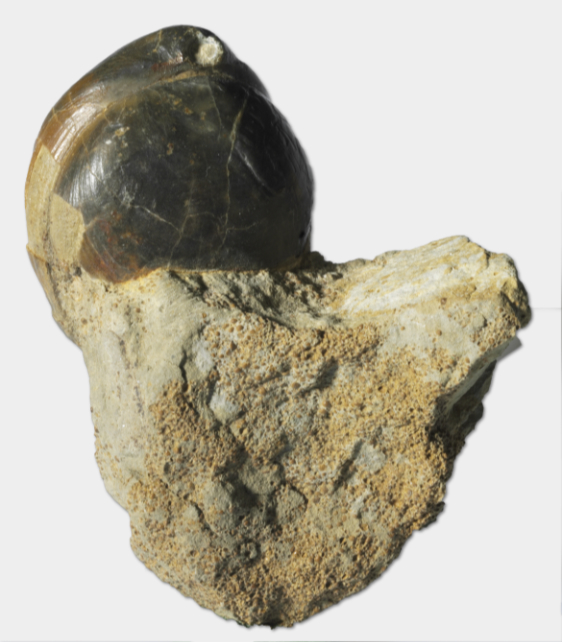July 2024: Brachiopod
Wattonithyris sp.
Inv.-no.: SNSB-BSPG 2020 XCVI 160
Middle Jurassic: Bathonian, ca. 168 mio. years old, Sengenthal/Ofr., diameter of the fossil: 5 cm.

With their bivalve shell, brachiopods at first glance resemble mussels (bivalvia), to which they are, however, not related. Rather, they belong to the group of lophophorates. A characteristic feature is the so-called mouth arms (lophophores) inside the shell, which are paired body extensions to the left and right of the mouth and have 1-2 rows of tentacles covered in cilia. The mouth arms of many brachiopods are supported by a calcareous arm structure, which can be in the form of a clasp, a loop or a spiral. The two shell halves (valves) surround the soft body as a horny-phosphatic or calcareous (calcitic) exoskeleton. A fleshy stalk protrudes from the lower, usually slightly larger valve, with which the brachiopods attach themselves to the substrate. Most brachiopods live on the sediment, some also live in the sediment. Some forms cement to hard ground. In rare (fossil) cases they even form smaller reef structures.
Brachiopods have been known since the Cambrian and had their maximum distribution in the Paleozoic Era. The Permian/Triassic mass extinction decimated the brachiopods, and in their further development the competitive pressure from mussels had a negative impact on their distribution. As a result, they are rather rare today. There are around 300 living genera compared to over 3000 fossil ones, which underlines the great importance of brachiopods in paleontology.
The fossil of the month Wattonithyris sp. belongs to the large group of terebratels, which are characterized by smooth shells and loop-shaped arm structures. Also typical is the circular opening in the larger valve, from which the fleshy stalk emerged in the living animal to attach the animal to the substrate.
As a result of a rise in sea level and the associated flooding of the Vindelizian Land, the southern German sea basin opened up on a broad front to the ancient Mediterranean, the Tethys, in the Middle Jurassic. In Central Europe, a shallow sea continued to spread, in which strong currents developed between the mainland areas, such as the Brabant Massif, the Rhenish Massif and the Bohemian Massif. This led to the formation of waves near the coast, which in turn promoted the formation of small egg-shaped spheres (ooids). Today, such structures are forming, for example, in the Bahamas or the Persian Gulf. A high level of iron input from the land led to the formation of iron oids in particular in the Middle Jurassic. The iron content in the Middle Jurassic sediments is responsible for their often brown or brown-red color, which is why the Middle Jurassic is also known as the “Brown Jurassic”. The iron comes from weathering products of the surrounding mainland, where laterite soils formed under tropical conditions. The iron it contained was washed into the coastal waters, where it was incorporated into the forming ooids in the form of limonite (brown ironstone). The fossil of the month still has a chunk of sediment attached to it, in which you can clearly see the rusty brown spherules.
Martin Nose, Munich
References:
- Schmidt-Kaler et al. (1992): Sulzkirchen und Sengenthal – zwei berühmte Fossilfundstellen am Rande der Frankenalb. – Wanderungen in die Erdgeschichte, 4, 112 S., Pfeil-Verlag (München).
- Meschede, M. (2015): Geologie Deutschlands – ein prozessorientierter Ansatz. – 249 S., Springer Verlag (Berlin, Heidelberg).



